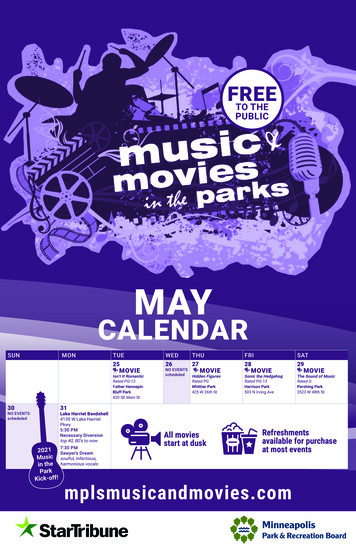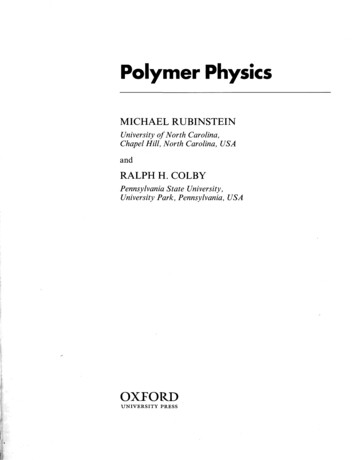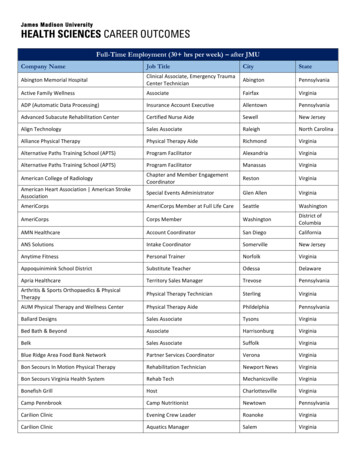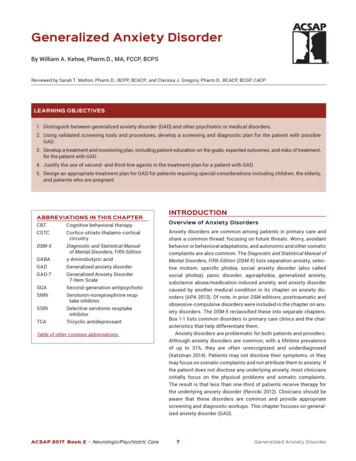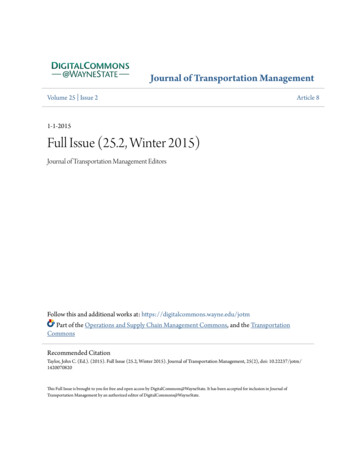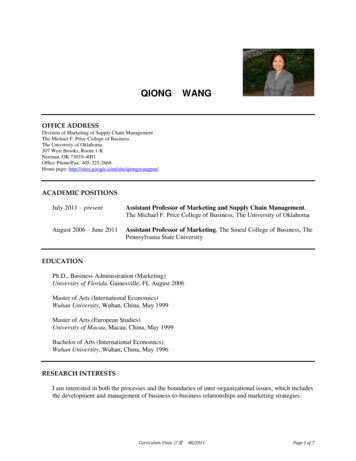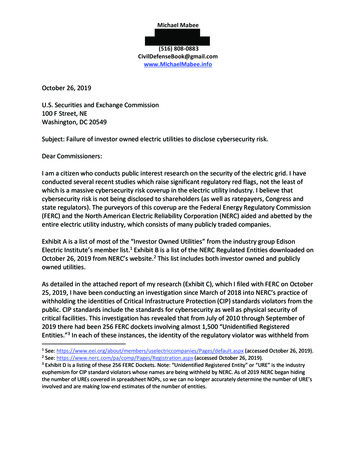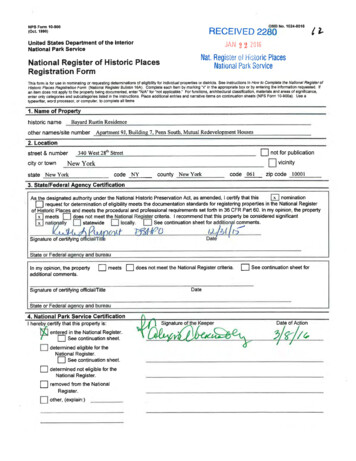
Transcription
University Park, PennsylvaniaProject Description and Background InformationSpring 2006Advisor: Dr. Michael HormanJason McFaddenConstruction ManagementSponsored by Barton Malow Company, The Pennsylvania State University, and L. Robert Kimball & Associates.
PROJECT DESCRIPTION AND BACKGROUND INFORMATIONPenn State Ballpark is a fast-track traditional project delivery system. Barton MalowCompany was hired by Penn State University to serve as the construction managementagency for the project, whereas L. Robert Kimball & Associates is the lead projectarchitect. The construction schedule for the project shows that construction began inJune 2005 and will finish in time for State College Baseball’s first minor league baseballgame slated for June 2006. An in-depth look at the building systems shows that thestadium shell is constructed using steel and load bearing masonry walls with brickveneer. The seating bowl is shaped using a slab-on-grade approach to form the seatingrisers. The original project cost when construction began in June 2005 was 23.8million; however the cost has since risen to 30.8 million.CLIENT INFORMATIONThe Pennsylvania State UniversityThe Pennsylvania State University is a very experienced owner during theconstruction of a facility. Within the Office of the Physical Plant (OPP) at PennState, there is a design and construction department solely for new and renovatedprojects for the University. Penn State has a set standard of procedures forprocuring design and construction professionals as well as contract administrationduring a project. Furthermore, OPP employs construction quality representativesto perform daily on-site inspections of the work being performed.The University is expecting a state-of-the-art facility but still maintain the overallproject budget for the project. Unfortunately, the project budget has beenincreased significantly for the project; the budget in May 2005 was 23.8M and asof September 2005 is 30.8M. This is partly due to the fact that there are manyproject players with different visions for the project. For example, from PennState there are representatives from OPP (several departments), Inter-CollegiateAthletics, Office of Telecommunications, Police Services, etc. In addition, theminor league affiliate also has a vision of the design for the project and wants toeliminate problems that have occurred at their other facility in Altoona. To helpguarantee the project will be delivered safely and with good quality, Penn StateUniversity has employed two (2) construction quality representatives (CQR) forthe project; this is different than past projects where only one CQR has beenassigned to a project. The University employed representatives perform dailyinspections of work-in-place and help to solve any issues Barton Malow is havingwith the L. Robert Kimball & Associates.With the State College Baseball organization being the lessee for the project, thisStadium project becomes the first project in the country to be conceived this way.State College baseball will lease the facility as well as provide the operation of theconcession stands for the events. The State College Baseball organization is anProject Description and Background Information2
affiliate of the Altoona Curve organization, and they hope to continue to have thesame success that is on-going in Altoona.Even though this facility will be used for baseball, the major concern theUniversity had was the affect the stadium will have on football parking. Becauseof this concern, Barton Malow completed the new 500 space north parking lot inAugust 2005 so it could be used for high-profile football parking. The only othermajor concern is the project must be finished by June 2006 because the minorleague team will begin its season then.Origination of the Project Over the past for years, Penn State has seen an increased need for a betterbaseball facility on campus. After setting aside money to renovate the currentfacility, Beaver Field, Penn State decided to entertain the idea of a first-classfacility with a minor league franchise. After much investigation and meetings with athletic personal, OPPrepresentatives, and the minor league affiliates, a state-of-the-art facility forboth the Penn State Baseball Team and a minor league franchise wasconceived. The baseball stadium site and design furthers the idea for Penn State to createan athletic village on the east edge of campus. The current baseball facility located on Park Ave. near Beaver Stadium willbe demolished and become additional football parking as well as a lockerroom facility for the men’s and women’s soccer team. The new stadium will also serve as a recruiting tool for the Penn StateBaseball team. The state-of-the-art facility will help attract prospectiveplayers to the join the Penn State Baseball team. Penn State also hopes to nowbe able to hold Pennsylvania state baseball championships with the newfacility. Furthermore, the minor league affiliate (State College Baseball) will helpattract more people to the University during the summer when campus is notas crowded.Design Guidelines The Open Spaces and Natural Systems concept will be used by preserving theview of Mount Nittany and incorporating an area for grass lawn seats in thedesign. The surrounding area will be landscaped with trees to preserve thenatural beauty of Penn State. The Architectural gridlines used for this building are community interface andpreserving a campus community. Since the building will be used to serveboth Penn State and the Minor league team there will be a strong communityinterface. This construction will further the idea of an “athletic village” on theeastern edge of campus.Project Description and Background Information3
Penn State must embrace the heritage of the Land Grant Institution bypromoting a strong agricultural image. This is embraced by maintaining arural area surrounding the new stadium This stadium will have a “campus in the fields” environment due to its treelined paths and low profile to the surroundings.Circulation Guidelines A bus stop along Porter Road will transport on campus students to the stadium Off Campus students and visitors will be able to utilize the commuter parkingor use the new 500 spaces that will be provided with the building. They willthen be able to visit the campus by way of the bus systems. Crosswalks will be added to the area surrounding the new stadium so that thewalking campus atmosphere will be maintained.Funding The project budget is 30.8 million including design costs as well as FF&E. Penn State will contribute the land, parking, intersection improvements andfive million dollars in gift funds invested by the Intercollegiate Athletics. Under the Pennsylvania Act 40, the State will contribute up to 12 million. There has also been a private donation made of 2.5 million for the project.EXISTING AND LOCAL CONDITIONSSite Location The site for the stadium is located near the intersection of Porter and CurtinRoad. The site is surrounded by Beaver Stadium, the Bryce Jordan Center and theMulti-Sport Indoor facility. Also located nearby are the Visitor Centre, Meats Lab, Pig Farms, and theCenter for Sustainability.Aerial View of Athletic Area at PSU (Baseball Stadium Site Circled)Topography In general, the site slopes north to south.Project Description and Background Information4
Soil and Groundwater Conditions Soil data is referenced from the United States Department of AgricultureNational Resources Conservation Service Soil Data Mart. The following six soils types are found in the construction area: HaA, HaB,HcB, HcC, No, and OhB. This means that there is bedrock significantly near the surface, implying theneed for blasting throughout the project.State College Township Concerns Since Sewage at State College Park will flow against gravity field, abooster/ejector will be installed to pump sewage uphill to existing facility. The formation of a bus stop along Porter Road will allow visitors to bedropped-off and picked-up. Since there will only be 500 parking spacesadded for the new stadium, bus and motor home parking will be provided bythe University at another location. Scheduling of events at the Stadium will not conflict with University events(ex. football games).Operating Times Penn State Baseball Team: March – May Minor League “A” Affiliate: June – SeptemberPreferred Construction Methods The typical construction method Penn State using on their project is a steelstructural system with concrete elevated slabs and a brick façade.Availability of Construction Parking The Stadium project is unique in the fact that there is an unlimited amount ofon-site parking at no cost for the project.Available Recycling and Tipping Fees Penn State is hoping to acquire a LEED Certification for the project. Cost to dispose 1 ton of waste in Centre County is 56.Project Description and Background Information5
MAINENTRANCEORTACRNT INGOBC R KSU PAFENCEERRTPOADR2rtoctra &no gecb ra ler duS Sto rai unT pomCo44ROINTRUCCM TRAILER23L. Robert Kimball & Assoc.Frick Building437 Grant StreetPittsburgh, PA 15219DLR Sports Group7290 W. 133rd StreetOverland Park, KS 66213DAO11&3DUMPSTERSBarton Malow Company200 Mansell Court EastSuite 100Roswell, GA 30076KEYERRTPOWELDING TANKSTORAGE AREASteel Delivery TruckSteel StagingConcrete Pump & HoseConcrete TruckROForkliftADSITE LAYOUT PLANSTEEL / CONCRETESEQUENCELOWERENTRANCENOTE: This is Jason McFadden's Interpretation of the Site Layout Plan for the Steel/Concrete Sequence.Scale: 3/32” 1’- 0”6C13.01
PROJECT SCHEDULE SUMMARYFoundation SequencePenn State Ballpark is constructed on a conventional spread footing foundationsystem. Foundation construction began in area D and moved to area E and B.Concurrent construction of the field wall and area A foundation also occurred.Before foundation construction could begin, there were eight (8) weeks of massexcavation to the entire project site.Structural/Exterior PhasesThe current steel erection sequence is divided into seven (7) phases by areas ofthe stadium; the stadium is divided into areas A, B, C, D, and E which arearranged in a counter-clockwise direction around the building. Steel erection willbegin in area D, and then move to area B, followed by area C, and then finish witharea A and E. Steel erection will finish with the erection of the light towers andscoreboard structure. The concrete floor slab construction will follow thestructural steel erection sequence. The masonry sequence begins withconstruction of load bearing walls in areas B and E and then will follow withareas C and D.Finish SequenceFinishes were sequenced through the building from area D to C and finishing inarea B. The majority of finishes in area D are in the basement level while area Band C are at the suite level.After HVAC and other major overhead equipment were in place, the finishes willbe phased in the following manner: Metal studs MEP Rough-In Ceiling Grid Insulation Gypsum Board Ceiling Grid Electrical Fixtures and Diffusers Ceiling Tiles Painting Carpeting and Other Floor Installations FurnitureProject Description and Background Information7
Project Description and Background Information8
The Stadium project is unique in the fact that there is an unlimited amount of . area A and E. Steel erection will finish with the erection of the light towers and scoreboard structure. The concrete floor slab construction will follow the structural
